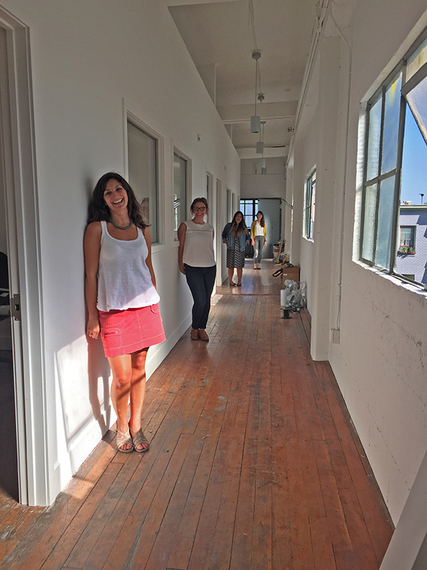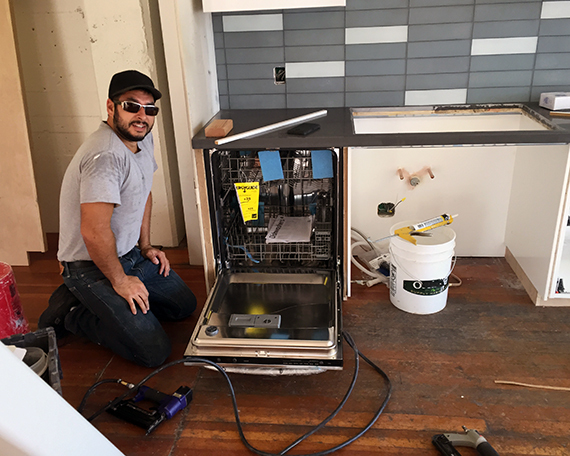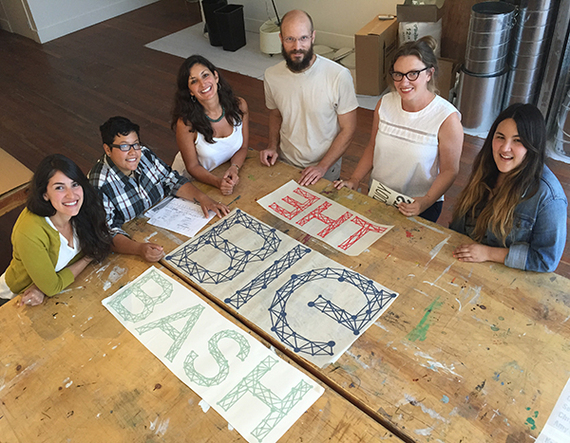
The Root Division team in their glorious new space: (l to r), Amy Cancelmo, Blake Gibson, Brooke Westfall, Michele Mansour, Leticia Salinas, and Susa Cortez.
An exam room poster (seen during a recent doctor's visit) notes that updated CPR technique requires one to apply rhythmic pressure to the chest while singing "Stayin' Alive" (in your mind, not necessarily aloud)--that specific song apparently guides one to the proper timing and rhythm of effective, life-saving chest compressions.
The prior afternoon, I'd spoken with Michelle Mansour and Amy Cancelmo. And although that catchy song typically provokes an image of white pantsuits and arms akimbo, instead, the words reminded me of Root Division:
Whether you're a brother or whether you're a mother
You're stayin' alive, stayin' alive
Feel the city breakin' and everybody shakin'
And we're stayin' alive, stayin' alive
Ah, ha, ha, ha, stayin' alive, stayin' alive
The last line celebrates staying alive amidst a city in flux--even laughing as adversity fades away in the rear view mirror. Which is exactly what Root Division seems to be doing these days--laughing and dancing as it celebrates its new location downtown.
It's no news that San Francisco's real estate boom has made it virtually impossible for self-sustaining independent art spaces to remain in the city. While some write off the current exodus of arts spaces and non-profits as merely cyclical, writer Christian Frock cannily observed,"...this time is different, in part because of the devastating impact new wealth is rendering on the fragile infrastructure of San Francisco's homegrown art scene and its artists, as well as small businesses, nonprofits, advocacy organizations, lower income communities, families with children, immigrants, the mentally ill and homeless, and the generally disenfranchised."
The departures in the past several years due to escalating rents have decimated the downtown area of arts venues, affecting blue chip commercial galleries as well as small independent spaces alike. Although this exodus continues unabated, there have been some success stories--but they are very few and far between. Which makes the survival of Root Division all that more remarkable.
This Saturday, September 12th, Root Division will open its grand, multi-story, light-filled new space, and the tale behind it is nothing short of incredible. Their survival provides an inspiring model of tenacity, positive thinking, forethought, goodwill, community support, and--probably most important--a sheer refusal to even think about failing.
Root Division hasn't merely survived, it has flourished. Its new space is huge. It has multiple levels, spacious windows with a city view, and a parking lot next door. It's right in the heart of the city, at Mission and 7th--only a block and a half away from the Civic Center transportation hub.
But wait, it's 2015. According to LoopNet, the average price per square foot for office space in San Francisco is $671.31. Indeed, Root Division, a small innovative arts non-profit formerly housed in the Mission, was only able to survive at its former 17th street location as long as it had because it was paying below-market rent--before the real estate boom. How did this happen?
Mansour and Cancelmo, the wunderkinds behind this miracle, do laugh a lot--and when I ask this question, they eye each other, smiling, as if they're not sure they should reveal the secret sauce.
Root Division's story starts thirteen years ago, around 2002, when three graduate students from the San Francisco Art Institute - Nathan Suter, Mitch Temple, and Dennis McNulty - were inspired by a class entitled "Artist as Endangered Species," taught by SFAI faculty Kate Eilertsen and Jeannene Przyblyski. Humbled by recent drastic cuts in arts funding and the attrition statistics--only 5% of artists continue to make artwork five years after graduate school--the trio decided to challenge that eventuality by creating a community art collective with the necessary recipe for successful artist survival: (1) affordable studio space to create work; (2) space and opportunities to show and sell artwork; and (3) a means of fostering career-related experience, e.g. teaching or gallery expertise. Adds Mansour, "Given the dire need for arts education in the public school system, an essential part of this model was that rather than the obligation of studio rent, artists would instead be granted studio space in exchange for their time and skills in teaching art classes, developing education curricula, and serving as gallery assistants or curators." The first iterations of Root Division were in migratory spaces--the Boom Boom Room, Hespe Gallery, and the Brava Theater--but they then settled into a 5000 square foot space at 17th and Shotwell. Ten years ago, in 2004, that street was still considered as fringing the outskirts of the city, and the space came "complete with a bullet hole in the window," laughs Cancelmo. But they were able to make it work nonetheless, partnering with their landlord (a non-profit agency for tutoring and mentoring at-risk teens) to fulfill their education mission.
They fulfilled their exhibition mission as well, beginning their Second Saturday Exhibition Series, which continues to this day. They've produced over 120 shows, showcasing over 400 artists annually, and celebrated the 10th anniversary of their exhibition series in January 2014.
Their artist space model also worked beautifully. They were able to fit 17-19 artists into 15 separate studio spaces, providing rent and artist services to their artist residents at half the market rate in exchange for a 12-hour per month commitment of time to provide services (teaching, design, exhibition planning and production, or staffing) back to the collective. They partnered with nearby local public schools to offer after-school arts classes (some even in Spanish), and offered revenue-generating adult classes as well.
Michelle Mansour, Amy Cancelmo, Brooke Westfall, and Leticia Salinas in the artist studio corridor of the new Root Division space
In 2005-06, the original founders relocated in pursuit of other endeavors. Michelle Mansour had become involved with the collective soon after she moved to the Bay Area in 2003, and quickly stepped into the leadership role. A year later, Amy Cancelmo joined the team, doing "everything you could do" - from interning to facilities management to curatorial and gallery administrative duties. Cancelmo left in 2008 to attend graduate school, but returned in 2011 once again, becoming Root Division's Art Programs Director. The collective's team grew to 6 staff members, with the addition of Leticia Salinas as Education Programs Director, Brooke Westfall as Communications & Development Manager, Blake Gibson as Installations & Facilities Manager, and Susana Cortez as Outreach and Programs Assistant.
And then came Fall of 2013. Root Division had just hosted its annual summer retreat, asking the big questions of the future: "What does growth mean for Root Division?" The answers: A bigger space with natural light (their 17th street space had very little of it). More artist studios for more artists. A 5-year plan (but the real estate market was terrible--they likely couldn't afford to get something better now). New strategies for revenue. A bigger profile to gain greater, wider support. And if, for the time being, they planned on making further improvements to the space they were in at 17th Street, they also needed to re-negotiate their current 2-year lease to a longer term, which would expire in January 2014.
Then, in November, they got the news - their landlord was increasing their rent by 40%. Even with several good-faith attempts to negotiate, a 40% increase swiftly became a 90% increase. With rents in the neighborhood tripling, Root Division and its landlord were unable to find a rent structure that was agreeable for both parties.
The next months were a flurry of attempts to re-negotiate their rent with their landlord--all of which failed. Everyone realized they suddenly were facing the hardest questions. Do they go dark? Do they go dim? Do they operate different things out of different locations? "We realized what makes us unique and what makes us strong is that all of what we do is in one place - artists and students benefit from that, and the staff is energized by it," observed Mansour. And they also concluded that if they were going to end up paying more rent, it was key to their mission to "be in the heart of San Francisco, instead of the periphery."
And, most important, they had to put on a brave, smiling face. Mansour frames it best. "In this kind of situation, you can work yourself into the vortex of negativity. We realized it was really essential we take the high road--sing a positive tune..." She pauses. "We also had these relationships with all the students there." They were serving a regular contingent of thirty-five to forty teens. Those same students were now watching them, waiting to see how they would react, what would happen, what Root Division would do. As Mansour and others recognized, "This is where the role-modeling happens--when situations get tough and ugly, how do you conduct yourself, what stance to you take?"
The situation also called for deep introspection about their mission, identity, and skill set. "Artists are creative problem solvers," Cancelmo observed. Their prior success had been built on finding partnerships and leveraging those relationships and opportunities--"becoming greater than the sum of our parts." Plus, they were firm in their belief of the rewards from "paying it forward." Mansoor smiles. "Here is where we decided we needed to cash in. Putting out that positive juju has come back to us a hundred-fold! Cast a wide net. Contact people you know who had been through similar situations. We had spent years building relationships with our partners, and people asked us for stuff all the time. Now we're going to ask them."
Ultimately, they decided to push ahead with a plan to relocate--somehow. And hell, why not shoot for the moon. In the spring of 2014, they spread the news through an email:
"After residing at 3175 17th Street for more than nine years, Root Division was recently informed that its rental payments would nearly triple. Although disappointed that Root Division must vacate its long-term home, the organization's Executive Director, Michelle Mansour, maintains a positive stance, viewing this transition as "an opportunity to plan the development of a vital new, sustainable arts facility" with an affordable long-term lease."
They then set forth tackling this impossible dream with intelligence and fierce tenacity, tapping into the skills and expertise of key advisory board members and supporters. "We got a lot of technical help--like talking to Courtney Fink, Executive Director of Southern Exposure" (who had gone through a similar crisis in 2009). They enlisted the skills of Sharon Tanenbaum, (formerly the Executive Director of SF Camerawork, also a small independent arts non-profit) to engage in strategic planning and a feasibility study, interviewing 21 stakeholders--who recommended that they raise $500,000 (which was 40% more than their current annual budget!) They tapped the expertise of Norris Communications, realizing the necessity of their building a bigger profile. They undertook a thorough financial assessment, determining alternative revenue streams and facilities strategic planning.
The time to vacate their old space was coming up with no real options in sight, but they decided it was critical for them to maintain visibility. "If we went dark, it would be so hard to come back," noted Mansour. So they found an interim location right on Market Street between 6th and 7th Street from a generous landlord offering a below-market rate, which enabled them to continue their presence, maintain their staff, and continue their revenue streams. "The city is super-invested in keeping organizations like us here," observed Mansour, "and support from CAST (San Francisco's Community Arts Stabilization Trust) was huge - it enabled us to pay our rent obligations during the transition."
Conrad Meyers installs a new dishwasher in the new Root Division kitchen.
They sought and received sound advice on who they should approach for financial support, when they should ask for it, and in what order. Thus, their hope that their positive juju would kick in also came true--their fundraising efforts-both internal (with their board) and external (with fund-raising campaigns, grant applications, foundations, and individual contributions) ended up being wildly successful. They exercised a range of strategies, receiving additional funding from the Drusie Davis Family Fund, the Walter & Elise Haas Fund, the San Francisco Arts Commission, and the Bothin Foundation. They raised over $200,000 from their board. They received dozens of donations from individual donors, ranging from $100 to $50,000. Their capital campaign, which began at $650,000, was so successful they increased it to a goal of $850,000, of which they've now raised 90%. (And their smart, forward thinking is reflected by the fact that the last $100,000 of the campaign is slated for Phase II, a building fund for more classroom space and additional studios in the basement level.)
The city's Office of Economic and Workforce Development (with staff member Ellyn Parker) also was key to their ultimately finding their new home. They looked at 60-70 spaces, had the donated services of two real estate attorneys on their advisory committee for lease reviews and negotiations, and were immensely fortunate to discover a future landlord who shared their vision--offering them a 10-year lease at ½ the market rate. Finally, in February 2015--16 months after the displacement ordeal had begun--they signed a long-term lease to their beautiful new space.
Root Division's new home is in the heart of the Mid-Market/SOMA arts district at 1131 Mission Street (at 7th). They are mere blocks from museums and art spaces like the Yerba Buena Center for the Arts, the SFMOMA, the Contemporary Jewish Museum, and MOAD. With 13,000 square feet in a multi-level stand-alone building, they now have twice as much space as their previous location, and can house studios for twice as many artists. In a nod to Root Division's seminal mission, Mansour remarked, "Our priority really was getting the artists working again--addressing artist displacement."
So much of this success story reflects the inherently benevolent nature and mission of Root Division, and the passionate, rigorous, brilliant vision of leaders Mansour, Cancelmo, and the Root Division board. Their mission, stated on their website, is steeped in the generosity of empowerment: "Root Division is a launching pad for artists, a stepping stone for educators, a door to creativity for youth, and a bridge for the public to become supporters of the arts." So it seems only fitting that the collective's clearly immense reserve of goodwill and community support fostered over the past twelve years has come back to serve and empower them, in spades.
And also key to this tale is their insistence on maintaining the mantra of positivity, despite all odds. Mansour explains, "Anyone that comes to me with displacement issues--it's the first thing I say. We were given that piece of advice by a couple of people on our advisory board--and it was the smartest move that we made." Cancelmo agrees. "It affects the way people see the organization. Even when we were having our closing party, people were giving us so much credit for staying positive." It's clear that such enduring positivity, and the collective goodwill that Root Division had built painstakingly over the years truly was the key to arriving where they are now--exactly where they wanted to be.
The Root Division team celebrates their new space this Saturday with "The Big Bash" and their inaugural exhibition, "Resonate."
The grand opening of Root Division is this weekend, with the VIP and public events happening Saturday night, featuring their inaugural exhibition "Resonate." This astonishing accomplishment merits a grand celebration, as Root Division has granted us a lovely lesson on what's possible--one that hopefully may resonate hope for the future of arts in the city.



